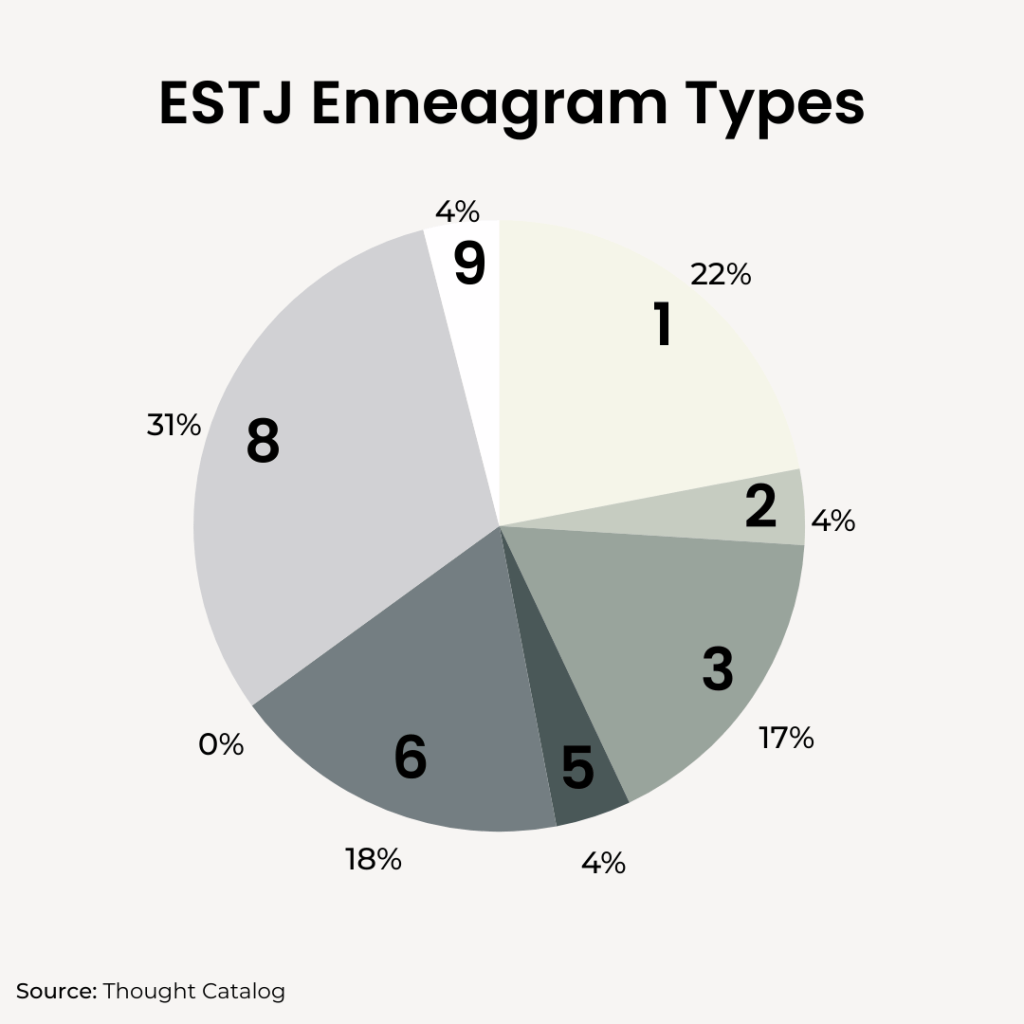How ESTJ Enneagram Types Differ
If you’ve found this blog post, you probably already know which of the 16 personality types you are. But do you know your Enneagram type? If not, you should definitely check it out – there’s a lot of valuable information to be gleaned from this personality theory.

If you’ve found this blog post, you probably already know which of the 16 personality types you are. But do you know your Enneagram type? If not, you should definitely check it out – there’s a lot of valuable information to be gleaned from this personality theory.
But even if you’re already familiar with the Enneagram, did you know that there’s a correlation between the 16 personality types and Enneagram?
While the 16 personalities model is more focused on how we interact with the world around us, the Enneagram framework delves deeper into our underlying motivations and basic fears.
So when you combine your 16 personalities type and your Enneagram type, you can get some even deeper insights into why you make decisions the way that you do or why you behave in certain ways.
Today, we’re going to take a look at how ESTJs relate to each of the nine Enneagram types. Keep reading for insights and tips on how to better understand yourself and others.
Which Enneagram types are most common among ESTJs?
According to a study conducted by Thought Catalog, the most common Enneagram type among ESTJs is Enneagram 8. This isn’t too surprising. Enneagram 8s are strong-willed, assertive, and direct. Plus, they’re independent and goal-oriented. These are the kind of ESTJs who are highly competitive and are always working towards a goal.

The second most common Enneagram type for ESTJs is Enneagram 1. Again, this isn’t a surprise. Enneagram 1s are principled and have a strong sense of right and wrong. They’re also perfectionists who are always striving to improve. These are the kind of ESTJs who are always working hard and pushing themselves to be the best that they can be.
Anyway, let’s save some thoughts for later on in the post.
How each Enneagram type manifests in ESTJs
Let’s now take a look at how ESTJs differ depending on their Enneagram type.
ESTJ Enneagram 1
This is the second most common Enneagram type for an ESTJ. ESTJs who identify as Enneagram 1 are even more of a perfectionist than your typical ESTJ. They’re logical and level-headed, but they also have a strong sense of right and wrong. In addition, they tend to analyze decisions very carefully. They want to be seen as ‘good’ people, and they are deeply dedicated.
ESTJ Enneagram 1s are the type of people who are always striving for the best. They are exceptionally dedicated, and they’re some of the hardest workers out there. In addition, they have a strong sense of self-control and are highly conscientious.
People of this type naturally pick up on inconsistencies and often have the desire to point them out or fix them. However, ESTJ Enneagram 1s are often hard on themselves and can benefit from learning to relax and go with the flow.
ESTJ Enneagram 2
ESTJs who identify as Enneagram 2 are more people-oriented and have a softer edge than your typical ESTJ. While most ESTJs enjoy spending time with people, particularly those close to them, they can be quite critical.
ESTJ Enneagram 2s have a more caring side. They’re always looking out for their loved ones and they’re quick to lend a helping hand. While they might not be nurturing in a warm, stereotypical sense, they are highly perceptive and they use this skill to pick up on other people’s needs. This comes from a place of genuinely wanting to help people.

In general, people of the ESTJ personality type are known for their consistency, reliability, and trustworthiness. These traits are even more accentuated in ESTJ Enneagram 2s. They take pride in being someone who can be counted on. However, ESTJ Enneagram 2s can be manipulative at times.
ESTJ Enneagram 3
ESTJs who identify as Enneagram 3 are even more driven and ambitious than your typical ESTJ. They’re always striving to be the best, and they’re even more competitive (if that’s possible!). ESTJ Enneagram 3s are charming people, and they are smooth when it comes to social interactions. They’re the kind of people who can talk their way into or out of anything.
ESTJ Enneagram 3s are quick thinkers, and they’re always looking for ways to improve. They’re never satisfied with mediocrity, and they push themselves to their limits. At times, they can be quite ruthless in their pursuit of success. They are natural leaders and are often very talented managers. ESTJ Enneagram 3s can find it hard to sit still, which is why they are always on the go.
In general, ESTJs are naturally perceptive of their environment, and they are highly aware of physical beauty. These characteristics are even more evident in ESTJ Enneagram 3s. This can mean that they are more image-conscious and concerned about what others think of them.
ESTJ Enneagram 4
ESTJ Enneagram 4s are more introspective and sensitive than your typical ESTJ. They’re also more self-aware and in touch with their emotions, which isn’t something that comes naturally to most ESTJs. Even ESTJ Enneagram 4s can struggle with this to some extent. This is why it’s a rare Enneagram type for ESTJs.
While most ESTJs are often very integrated into social groups, ESTJ Enneagram 4s can feel a little misunderstood, and they sometimes live with a sense of being ‘different.’ They have a desire for self-expression and might find themselves drawn to the arts. This ties in with the fact that they are often more creative than your typical ESTJ.
ESTJ Enneagram 4s tend to be slightly more individualistic, which isn’t seen in many ESTJ Enneagram types. People of this type often have a deep understanding of human nature, and they can be quite perceptive when it comes to other people’s emotions. However, their heightened awareness of their own emotions can make them susceptible to depression and anxiety.
ESTJ Enneagram 5

ESTJ Enneagram 5s tend to be more cerebral than your typical ESTJ. They’re highly intelligent, and they love to learn new things. In addition, they tend to make more calculated decisions and they don’t have that impulsive streak that can be seen in some ESTJs. This is a fairly rare Enneagram type for ESTJs.
People of this type are also quite independent and self-sufficient. In fact, ESTJ Enneagram 5s tend to be less extroverted and they can find socializing more draining. They tend to need more alone time to themselves so that they can think and process information. This type is often very good at problem-solving and they’re quick thinkers.
While ESTJs tend to be resourceful and intelligent in a practical sense, ESTJ Enneagram 5s are excellent at analyzing information and data. In addition, they’re quick to notice inconsistencies that others might miss. However, they can be arrogant and condescending when they think they are right.
ESTJ Enneagram 6
ESTJ Enneagram 6s tend to be more anxious and uncertain than your typical ESTJ. Most ESTJs tend to take a decisive and deliberate approach to life — they have a certain confidence when making decisions. However, ESTJ Enneagram 6s are more cautious and risk-averse when it comes to making decisions and trying new experiences.
ESTJ Enneagram 6s are very loyal and protective of their loved ones. They’re the kind of people who would do anything for their family and friends. In fact, people of this type value loyalty above all else. In general, ESTJs take pride in sticking to their word, and ESTJ Enneagram 6s take this even more seriously. You can always count on them to follow through. They value being part of a group, and they often have a strong sense of community.
People of this type like to plan for multiple scenarios because they are very focused on safety and security. However, imagining all the different ways a situation might play out can be a struggle for ESTJs. In addition, they can need a lot of reassurance from others at times. They can also be prone to paranoia and worry. This means that they can be quite pessimistic.
ESTJ Enneagram 7
This is a very rare Enneagram type for ESTJs. ESTJ Enneagram 7s are more enthusiastic and open to new experiences. They are more open to new experiences than your typical ESTJ. While a lot of ESTJs can find it hard to relax, ESTJ Enneagram 7s don’t have as much of a problem with this. Ultimately, they need to be kept on their toes because they don’t cope well with boredom.
People of this type seek out adventure and sensory stimulation. In addition, they aren’t afraid to push boundaries, but they like to stick to the rules! They take the view that it’s worth taking risks for new experiences. However, their rashness can cross over into the territory of being impulsive, which can sometimes get them into trouble.
ESTJ Enneagram 7s have a slightly more scattered thought process. They’re always thinking about the next thing, and they can find it hard to focus on one task for too long. This can make them seem a little chaotic from the outside, but there is usually a method to their madness. People of this type often have many goals that they’re working towards at any given time.
ESTJ Enneagram 8
This is the most common Enneagram type for ESTJs. ESTJ Enneagram 8s are your typical ambitious, competitive ESTJs. They are assertive, direct, and aggressive, always striving to be the best. As a result, they have a tougher edge than other ESTJs, and they can come across as intimidating.
People of this type are also natural leaders who are quick to take charge. In addition, they’re very confident, and they have no problem speaking their mind. While most ESTJs are resourceful, ESTJ Enneagram 8s are especially so. They’re always looking for ways to get ahead, and they’re very driven.
However, their competitive nature can sometimes make them seem arrogant, and they can have a hard time losing. In addition, their drive to succeed can lead them to make rash decisions. But ESTJ Enneagram 8s are also quick-thinkers, and they’re very good at problem-solving on the fly.
ESTJ Enneagram 9
ESTJ Enneagram 9s are more easy-going and agreeable than your typical ESTJ. They’re peacemakers who strive to maintain harmony. In addition, they’re more comfortable letting others take the lead in some situations, which isn’t a trait that’s seen in many other ESTJ Enneagram types.
People of this type tend to be more patient and willing to compromise. While ESTJs aren’t easy-going in general, ESTJ Enneagram 9s are more adaptable. However, ESTJ Enneagram 9s can be very resistant to change because they can view it as a disruption to harmony.

ESTJs tend to be outgoing and dynamic. However, ESTJ Enneagram 9s are a little calmer. They are better able to read people, and they use these skills to mediate conflict when necessary. Ultimately, they like to maintain a sense of peace. As a result, they tend to be more diplomatic when resolving conflict.
Nuances between ESTJ Enneagram types
So there you have it, the nuances between ESTJs of different Enneagram types. While we have focused on the differences in this post, it’s important to remember that you’re still an ESTJ, first and foremost.
This means that you likely enjoy being active, and you’re focused on efficiency. There’s a good chance that you’ll also be reliable, goal-oriented, and organized. However, your exact Enneagram type will play a role in how specific traits are expressed.
Particularly if you’re one of the less common ESTJ Enneagram types, we hope this post has provided insight into why you might not fit the stereotype of an ESTJ.
Final thoughts on ESTJ Enneagram types
If you enjoyed this post, you might also like How ISTJ Enneagram Types Differ. Finally, if you liked this post, share it with friends so they can better understand the differences between the ESTJ Enneagram types.




